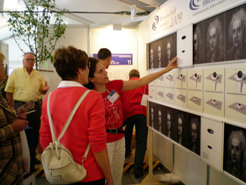Project of the Albert Einstein Institute wins first place in the “Science interactive” competition
The award, which is endowed with 10,000 Euros, was presented today at the Summer of Science festival in Saarbrücken.

The team of the Max Planck Institute for Gravitational Physics (Albert Einstein Institute, AEI) at the Science Summer in Saarbrücken is overjoyed: the exhibition "From Newton to Einstein: A Journey Through Space and Time" was able to win over its audience. The visitors decided that the AEI project should receive the award for the best popular presentation of a scientific research topic. A special feature contributed to the success of the project: the experiments were supervised by high school graduates and young students, who served as “guides” to the visitors, explaining the relationships involved to them. The “guides” had great fun acquainting themselves with the topic and passing their enthusiasm for mathematics and physics on to the visitors.
"We are extremely happy that we were able to spark our visitors’ enthusiasm for mathematical ideas," stated Carla Cederbaum, whose research topic is presented at the booth with experiments and exhibits. For example, at the AEI booth, the public can explore just how curved space feels and what it is that is “relative” in the theory of relativity. The basic idea of Einstein’s - mathematically very demanding – general theory of relativity can thereby be experienced in a manner perceptible to the senses.
The money associated with this reward, which is bestowed by the Stifterverband für die deutsche Wissenschaft together with Wissenschaft im Dialog, is to be used for further public relations work. The Science Summer - a science festival with a tent exhibition, demonstrations and lectures – will continue until 26.6. on the Tbilisser Platz in Saarbrücken.
Background to "From Newton to Einstein: A Journey through Space and Time"
We live in both Newton’s and Einstein's world. In Newton's world, the apple falls from the tree, because it is attracted to the earth. The same law of gravity explains the motion of the planets. In Einstein's world, the geometry (curvature) of four-dimensional space-time replaces the concept of gravitational force. For Newton, all information is transmitted instantaneously; that is, at infinite speed. For Einstein the limiting factor is the speed of light or “c,” which introduces a speed limit of just about 300,000 km/s. For Newton space is flat; space and time are independent concepts. For Einstein space and time are curved and interwoven to form four-dimensional space-time. The formal aspects of each theory are very different.
Newton's description is perfectly adequate for many calculations. Einstein's general theory of relativity gains relevance when examining systems with large masses, velocities and energies, e.g. phenomena in the universe, such as black holes, neutron stars, or star explosions. In everyday life we need to take the consequences of relativity theory into account when working with a GPS (Global Positioning System). These matters are therefore made relevant to the everyday life of visitors to the Science Summer, giving insight into current mathematical research that examines the effects and intersection points of both theories.
Newton's theory is regarded as a limiting case of Einstein's general theory of relativity. However, it is not yet possible to predict in which area Newton's theory actually represents a good approximation for the systems under investigation. In her scientific work, Carla Cederbaum examines the so-called Newtonian limes, i.e. the boundary region, in which the Newtonian approximation for the first time provides a drastically different prediction than Einstein's own theory (non-linear deviation). It is therefore important to understand both conceptually and quantitatively exactly how the transition from Newton's theory of gravitation to the general theory of relativity proceeds.
The investigation of the Newtonian limes was already initiated in the 1920s by Albert Einstein. Nevertheless, the limes is not fully understood, either conceptually or in terms of their consequences. A better understanding of it would increase both the potential of numerical simulations of gravitational phenomena, as well as a methodologically sound prediction of astronomically measurable deviations from Newton's theory. Moreover, a deeper understanding of the Newtonian limes is necessary to demonstrate the internal consistency of modern gravitational physics.










